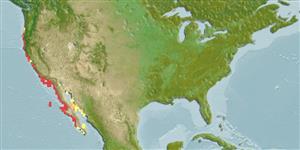>
Atheriniformes (Silversides) >
Atherinopsidae (Neotropical silversides) > Atherinopsinae
Etymology: Atherinopsis: Greek, atherina, the Greek name for the eperlane; 1770 + Greek,ops = appearance (Ref. 45335).
More on author: Girard.
Environment: milieu / climate zone / depth range / distribution range
Écologie
marin; profondeur ? - 30 m (Ref. 37955). Subtropical; 46°N - 22°N, 129°W - 110°W
Eastern Pacific: Yaquina Bay in Oregon, USA to southwestern coast of Baja California, Mexico.
Taille / Poids / Âge
Maturity: Lm ? range ? - ? cm
Max length : 45.0 cm TL mâle / non sexé; (Ref. 9273); common length : 40.0 cm TL mâle / non sexé; (Ref. 9273); âge max. reporté: 11 années (Ref. 56049)
Épines dorsales (Total): 6 - 10; Rayons mous dorsaux (Total): 114; Épines anales 1; Rayons mous anaux: 21 - 26; Vertèbres: 50 - 54. Branchiostegal rays: 5-6 (Ref. 36497).
Adults inhabit inshore areas, including bays (Ref. 2850). Form schools (Ref. 2850). Demersal spawners in nearshore habitats (Ref. 56049). Oviparous, with planktonic, primarily neustonic larvae (Ref. 36497). Eggs are attached to one another by spawning substrate via adhesive filaments (Ref. 36497). Sold fresh (Ref. 2850).
Eschmeyer, W.N., E.S. Herald and H. Hammann, 1983. A field guide to Pacific coast fishes of North America. Boston (MA, USA): Houghton Mifflin Company. xii+336 p. (Ref. 2850)
Statut dans la liste rouge de l'IUCN (Ref. 130435)
Menace pour l'homme
Harmless
Utilisations par l'homme
Pêcheries: commercial
Plus d'informations
RéférencesAquacultureProfil d'aquacultureSouchesGénétiqueElectrophoresesHéritabilitéPathologiesTraitementNutrientsMass conversion
CollaborateursImagesStamps, Coins Misc.SonsCiguateraVitesseType de nageSurface branchialeOtolithesCerveauxVision
Outils
Articles particuliers
Télécharger en XML
Sources Internet
Estimates based on models
Preferred temperature (Ref.
123201): 12.8 - 24.2, mean 20.7 °C (based on 122 cells).
Phylogenetic diversity index (Ref.
82804): PD
50 = 1.0000 [Uniqueness, from 0.5 = low to 2.0 = high].
Bayesian length-weight: a=0.00724 (0.00392 - 0.01338), b=3.01 (2.84 - 3.18), in cm total length, based on LWR estimates for this species & (Sub)family-body (Ref.
93245).
Niveau trophique (Ref.
69278): 2.3 ±0.21 se; based on food items.
Résilience (Ref.
120179): Milieu, temps minimum de doublement de population : 1,4 à 4,4 années (tm=2.5; Fec = 6,000).
Fishing Vulnerability (Ref.
59153): Low to moderate vulnerability (35 of 100).
Nutrients (Ref.
124155): Calcium = 97.3 [52.9, 183.3] mg/100g; Iron = 1.34 [0.75, 2.26] mg/100g; Protein = 18.9 [16.6, 21.5] %; Omega3 = 0.259 [0.117, 0.644] g/100g; Selenium = 21.5 [10.3, 46.7] μg/100g; VitaminA = 11 [3, 41] μg/100g; Zinc = 1.13 [0.80, 1.61] mg/100g (wet weight);
